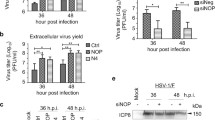Abstract
As a product of HSVI immediate-early gene, ICP22 is capable of interacting with various cellular transcriptive and regulatory molecules during viral infection so as to impact the normal cellular molecular mechanism. ICP22 expressed in transfected cells can push the cells’ entering into S phase with binding to mdm-1 promoter region and impact its trans-transcription activating effect by P53. Consequently, the MDM-2 binds to P53, and the degradation effects by the ubiquitous pathway are decreased, improving indirectly the P53 levels in cells and making the cells progress into the S phase.
Similar content being viewed by others
References
Wildy P. Herpes: History and classification. In: Kaplan A S, ed. The Herpesviruses. New York: Academic Press, 1973
Rock D L, Fraser N W. Detection of HSV-1 genome in central nervous system of latently infected mice. Nature, 1983, 302: 523–525
Pilon L, Kessous-Elbaz A, Langelier Y, et al. Transformation of NIH 3T3 cells by herpes simplex type 2 Bg1II n fragment and sub-fragments is independent from induction of mutation at the HPRT locus. Biochem Biophys Res Commun, 1989, 159(3): 1249–1255
Wu M Y, Wu X Y, Zhuang C X. Detection of HSV and EBV in esophageal carcinomas from a high-incidence area in Shantou China. Dis Esophagus, 2005, 18(1): 46–50
Honess R W, Roizman B. Regulation of herpesvirus macromolecular synthesis: Sequential transition of polypeptide synthesis requires functional viral polypeptides. Proc Natl Acad Sci USA, 1975, 72(4): 1276–1280
Cun W, Li Q H. Development on study of HSVI immediate-early gene. Section of Viology Foreign Medical Science, 2003, 10(5): 129–132
Deshpande A, Sicinski P, Hinds P W. Cyclins and cdks in development and cancer: A perspective. Oncogene, 2005, 24(17): 2909–2915
Oren M, Damalas A, Gottlieb T, et al. Regulation of p53: intricate loops and delicate balances. Ann N Y Acad Sci, 2002, 973: 374–383
Harris S L, Levine A J. The p53 pathway: positive and negative feedback loops. Oncogene, 2005, 24(17): 2899–2908
Advani S J, Weichselbaum R R, Roizman B. The role of cdc2 in the expression of herpes simplex virus genes. Proc Natl Acad Sci USA, 2000, 97(20): 10996–11001
Bruni R, Roizman B. Herpes simplex virus 1 regulatory protein ICP22 interacts with a new cell cycle-regulated factor and accumulates in a cell cycle-dependent fashion in infected cells. J Virol, 1998, 72(11): 8525–8531
Zauberman A, Flusberg D, Haupt Y, et al. A functional p53-responsive intronic promoter is contained within the human mdm2 gene. Nucleic Acids Res, 1995, 23(14): 2584–2592
Ogle W O, Roizman B. Functional anatomy of herpes simplex virus 1 overlapping genes encoding infected-cell protein 22 and US1.5 protein. J Virol, 1999, 73(5): 4305–4315
Long M C, Leong V, Schaffer P A, et al. ICP22 and the UL13 protein kinase are both required for herpes simplex virus-induced modification of the large subunit of RNA polymerase II. J Virol, 1999, 73(7): 5593–5604
Jahedi S, Markovitz N S, Filatov F, et al. Colocalization of the herpes simplex virus 1 UL4 protein with infected cell protein 22 in small, dense nuclear structures formed prior to onset of DNA synthesis. J Virol, 1999, 73(6): 5132–5136
Leopardi R, Ward P L, Ogle W O, et al. Association of herpes simplex virus regulatory protein ICP22 with transcriptional complexes EAP, ICP4, RNA polymerase II, and viral DNA requires posttranslational modification by the UL13 protein kinase. J Virol, 1997, 71: 1133–1139
Bruni R, Fineschi B, Ogle W O, et al. A novel cellular protein, p60, interacting with both herpes simplex virus 1 regulatory proteins ICP22 and ICP0 is modified in a cell-type-specific manner and is recruited to the nucleus after infection. J Virol, 1999, 73(5): 3810–3817
Author information
Authors and Affiliations
Corresponding author
Additional information
These authors contributed equally to this work
Supported by the National Natural Science Foundation of China (Grant No. 30570081)
Rights and permissions
About this article
Cite this article
Guo, H., Cun, W., Liu, L. et al. Immediate-early gene product ICP22 inhibits the trans-transcription activating function of P53-mdm-2. SCI CHINA SER C 50, 473–478 (2007). https://doi.org/10.1007/s11427-007-0039-8
Received:
Accepted:
Issue Date:
DOI: https://doi.org/10.1007/s11427-007-0039-8




